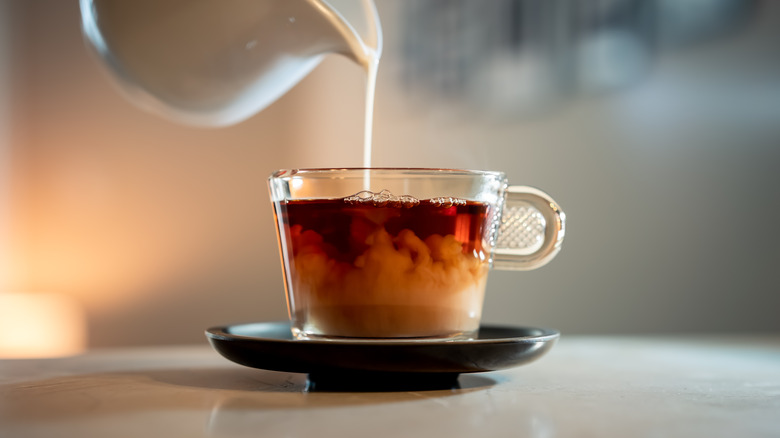The Right Way To Add Milk To Your Tea, According To Science
"Would you like a cup of tea?" It's a simple question that summons civility into an otherwise chaotic day. However, there is nothing simple about the very strong (and often opposing) opinions people have regarding how tea should be brewed, presented, consumed, and more. Never fear; science is here.
At least on the matter of milk and when to add it, research from the Royal Society of Chemistry makes what appears to be an inarguable case. Spoiler alert: They say it is best to add the milk first. Dr. Andrew Stapley, a chemical engineer from Loughborough University, explained to The Guardian that pouring milk into hot tea breaks down the milk and separates it into little droplets rather than keeping its cool, creamy flow. "This is much less likely to happen if hot water is added to the milk," said Stapley.
Centuries ago, it was a standard British tea ritual to add milk to delicate (and fragile) porcelain teacups before pouring freshly brewed tea from a teapot. The British Museum notes that the cool milk would save British teacups and bowls from cracking under a direct pour of scalding hot tea.
With seemingly both science and history on its side, the practice of serving tea in this manner sounds straightforward enough, save for one problem: A chemist for Britain's Tea Advisory Panel says tea's health benefits are compromised by pouring milk in first.
Why milk-first tea might be bad for your health
Dr. Tim Bond, a chemist and participant on Britain's Tea Advisory Panel, says adding milk to your mug before you pour hot water over your tea bag compromises the healthy effects of tea. Specifically, the milk-in-first method messes with tea's flavonoids.
Bond spoke to the Mirror about the type of flavonoids we glean from our cups of tea. Those fragile flavonoids (specifically flavan-3-ols, the kind from plants) are better off if the tea brews for three to five minutes before adding milk. The habit of using a teapot to brew tea is no longer the norm; what generally happens is hot water is poured over a tea bag already in your mug. Therefore, putting milk first means less brew time to develop those flavonoids under scalding hot water.
We do not want to sacrifice our flavonoids. According to the NIH, flavonoids have cancer-preventative, antioxidant, antiviral, anti-inflammatory, and other healing properties that improve our memory and heart health.
Bond would like to relegate the concept of adding milk first to a hanging-on habit from centuries ago. He hopes to make the case that milk-in-first is a ritual for the history books, not modern days. However, if you're committed to the practice, Bond told the Mirror, "...the benefits of drinking tea are such that what's important is to drink it rather than not."

